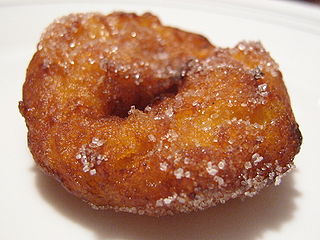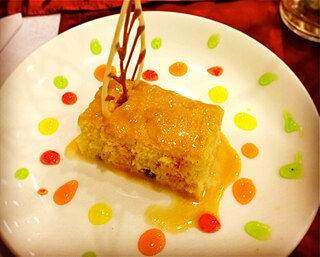 W
WNicaraguan cuisine includes a mixture of indigenous Native American cuisine, Spanish cuisine, and Creole cuisine. Despite the blending and incorporation of pre-Columbian and Spanish-influenced cuisine, traditional cuisine differs on the Pacific coast from the Caribbean coast. While the Pacific coast's main staple revolves around beef, poultry, local fruits, and corn, the Caribbean coast's cuisine makes use of seafood and coconut.
 W
WArroz a la valenciana or Valencian rice is a name for a multitude of rice dishes from diverse cuisines of the world, which originate from the rice-growing tradition of Valencia, in eastern Spain.
 W
WA buñuelo is a fried dough fritter found in Spain, Latin America, Israel, and other regions with a historical connection to Spaniards or Sephardic Jews, including Southwest Europe, the Balkans, Anatolia, and other parts of Asia and North Africa. Buñuelos are traditionally prepared at Christmas, Ramadan, and among Sephardic Jews at Hanukkah. It will usually have a filling or a topping. In Mexican cuisine, it is often served with a syrup made with piloncillo.
 W
WChayote, also known as mirliton, güisquil, pimpinela and choko, is an edible plant belonging to the gourd family, Cucurbitaceae. This fruit was first cultivated in the Mesoamericas between southern Mexico and Honduras, with the most genetic diversity available in both Mexico and Guatemala. It is one of the several foods introduced to the Old World during the Columbian Exchange. Also during this period, the plant spread from to other parts of the Americas, ultimately causing it to be integrated into the cuisine of many other Latin American nations.
 W
WChicha is a fermented (alcoholic) or non-fermented beverage of Latin America, emerging from the Andes and Amazonia regions. In both the pre- and post-Spanish conquest periods, corn beer made from a variety of maize landraces has been the most common form of chicha. However, chicha is also made from a variety of other cultigens and wild plants, including, among others, quinoa, kañiwa, peanut, manioc, palm fruit, rice, potato, oca, and chañar. There are many regional variations of chicha. In the Inca Empire, chicha had ceremonial and ritual uses.
 W
WChicharrón is a dish generally consisting of fried pork belly or fried pork rinds. Chicharrón may also be made from chicken, mutton or beef.
 W
WChurrasco is the Portuguese and Spanish name for beef or grilled meat more generally. It is a prominent feature in the cuisine of Brazil, Uruguay and Argentina. The related term churrascaria is mostly understood to be a steakhouse.
 W
WCuajada is a cheese product. Traditionally it is made from ewe's milk, but now it is more often made industrially from cow's milk. It is popular in the northern regions of Spain. In Latin America it is popular in Colombia and in the Central American countries of El Salvador, Honduras and Nicaragua.
 W
WFlor de Caña is a brand of premium rum manufactured and distributed by Compañía Licorera de Nicaragua which is headquartered in Managua, Nicaragua and dates back as far as 1890.
 W
WIn English, fritanga refers to a restaurant that makes home-style Nicaraguan foods. The staple foods at a fritanga may include gallo pinto, arroz blanco, carne asada, tajada frita, platano frito, maduros, yuca, queso frito, tortilla and cabbage salad. Fritangas also carry daily specials such as: salpicón, ropa vieja, carne desmenuzada, and enchiladas, as well as speciality drinks and desserts/pastries. Fritangas have a cafeteria (comideria) style of ordering and the food can be taken out or consumed at the establishment.
 W
WGallo pinto or gallopinto is a traditional dish from Central America. Consisting of rice and beans as a base, gallo pinto has a long history and is important to Costa Rican and Nicaraguan identity and cultures, just as rice and beans variations are equally important in many Latin American cultures as well.
 W
WA güirila is a sweet type of tortilla made from young white maize. They are usually eaten with crema and cuajada, a type of salty Nicaraguan crumbled white cheese.
 W
WThe Macuá is a cocktail made with white rum and fruit juices, usually lemon and guava juice. The Macuá is noted as the national drink of Nicaragua. The drink is named after pajaro macuá, a tropical bird native to the country.
 W
WA nacatamal is a traditional dish found in Nicaragua similar to the tamal. Its name originates from the nawat language spoken by the Nicarao, which were situated on the Southern Pacific coast of Nicaragua, and translates to "meat tamale". The nacatamal is perhaps the most produced within traditional Nicaraguan cuisine and it is an event often reserved for Sundays at mid-morning, it is usually eaten together with fresh bread and coffee. It is common to enjoy nacatamales (plural) during special occasions and to invite extended family and neighbors to partake.
 W
WPinolillo is a sweet cornmeal and cacao-based traditional drink in Nicaragua, also consumed in Costa Rica. It is made of ground toasted corn and a small amount of cacao. It can be mixed with water or milk, and served sweetened or unsweetened. If unsweetened, it is rather bitter. It can also be used in cooking some local dishes, such as garrobo con pinol or pinol de hola. The drink usually has a rough, gritty texture.
 W
WSalsa criolla is a type of salad or relish found in Latin American cuisine, composed of finely chopped sliced onions, vinegar, tomatoes, garlic, chili peppers, bell peppers olive oil, salt, pepper and fresh herbs like parsley or cilantro. Salsa criolla is often associated with Peruvian cuisine, but also found in Cuban, Puerto Rican, Nicaraguan, Uruguayan, and Argentinian cuisine.
 W
WSopa de mondongo is a soup made from diced tripe slow-cooked with vegetables such as bell peppers, onions, carrots, cabbage, celery, tomatoes, cilantro, garlic or root vegetables. The dish is generally prepared in former Spanish colonies in Latin America, Caribbean, and in the Philippines.
 W
WTajada "slices" is a dish of fried plantains that are sliced long. It is a typical food of Caribbean countries as well as Nicaragua, Colombia, Honduras, Panama, and Venezuela. It is sometimes served with grated cheese.
 W
WTostones are twice-fried plantain slices commonly found in Latin American cuisine and Caribbean cuisine. Most commonly known as tostones, Puerto Rico, Jamaica, Nicaragua, Cuba, Honduras and Venezuela, they are also known as tachinos or chatinos (Cuba), platano frito or frito verde, bananes pesées (Haiti), patacones and, sometimes, patacón pisao in Colombia.
 W
WA tres leches cake, also known as pan tres leches, is a sponge cake—in some recipes, a butter cake—soaked in three kinds of milk: evaporated milk, condensed milk, and heavy cream.
 W
WVaho or baho is a mix of meat, green plantains and yuca cooked in banana leaves. It is a traditional Nicaraguan dish originated from the mix of cultures between the indigenous, mestizos and Afro-Nicaraguans of the country.
 W
WVigorón is a traditional Nicaraguan dish. It consists of a cabbage salad, boiled yuca, and charrascaes, all wrapped in a banana leaf. This dish is often eaten without utensils, and it is frequently served to visiting family and guests, as it is generally easily and quickly prepared.